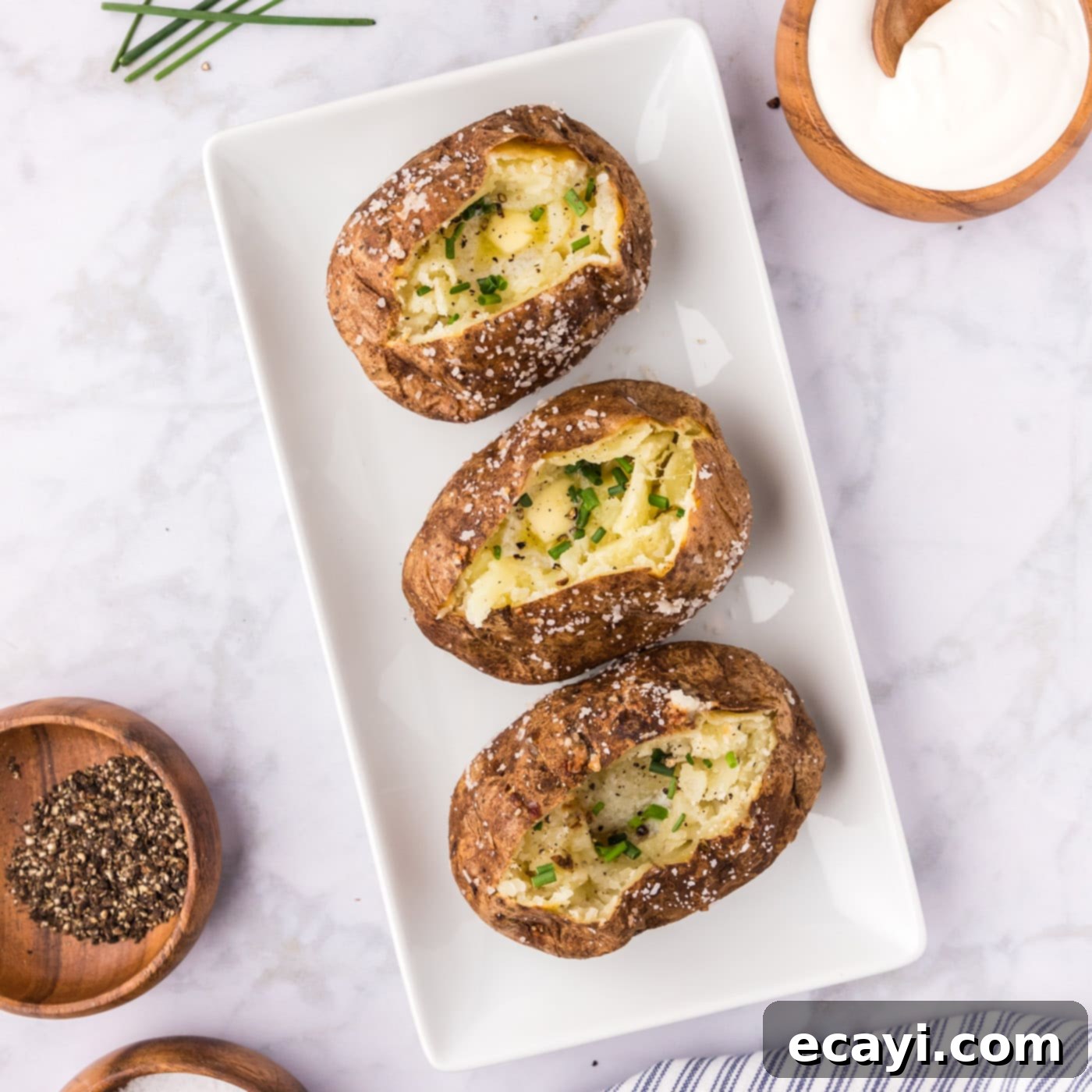The Ultimate Guide to Perfectly Fluffy Baked Potatoes with Crispy Skin
Achieving a perfectly fluffy baked potato with irresistibly crispy skin might seem like a culinary challenge, but it’s surprisingly simple. With just three basic ingredients, a standard oven, and a few quick punctures with a fork, you can create a side dish or main meal that’s wonderfully tender on the inside and delightfully crisp on the outside. These humble spuds are the ideal canvas for a myriad of toppings, begging to be loaded with all your favorite flavors and textures.
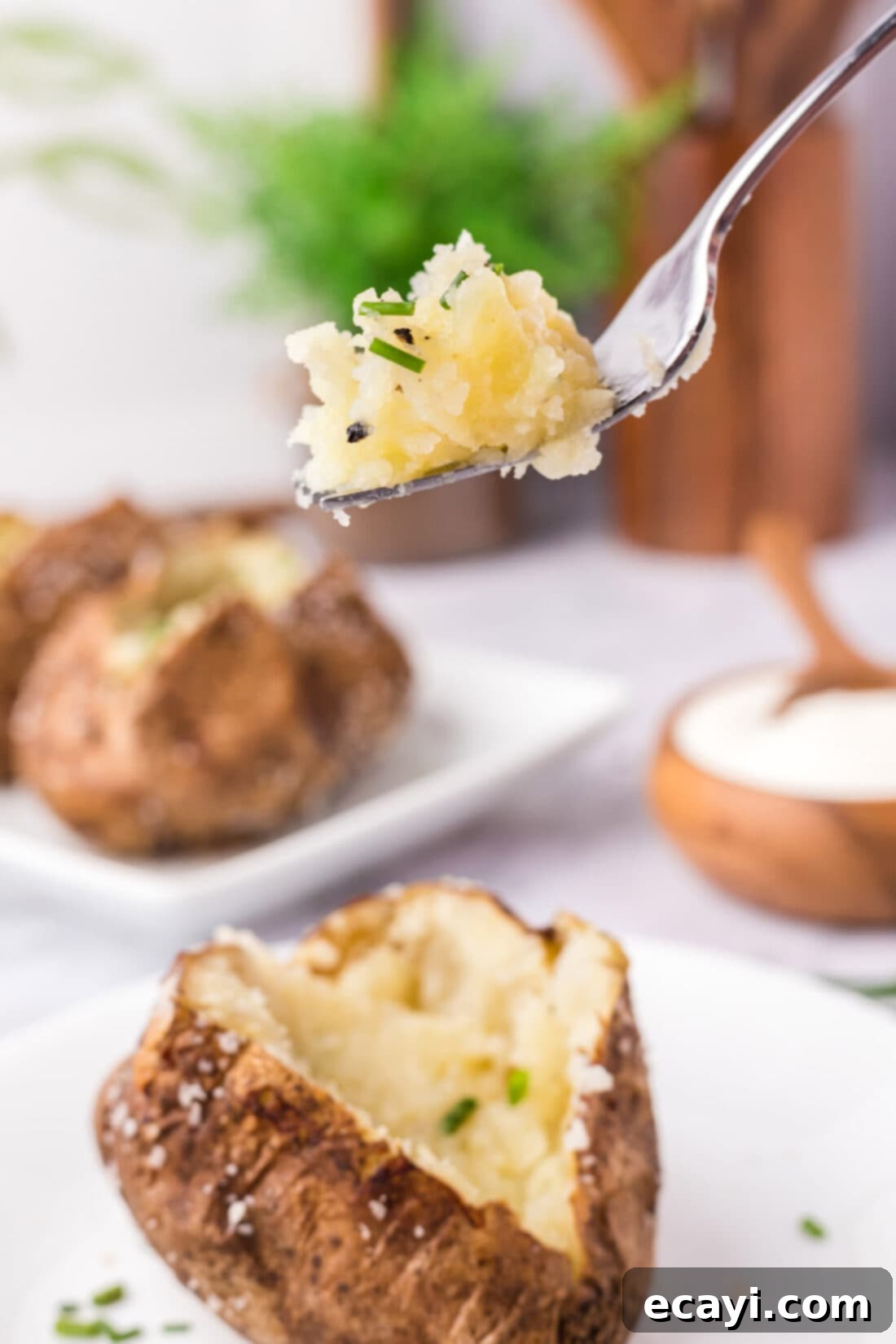
Why This Simple Baked Potato Recipe Guarantees Success Every Time
The secret to a truly great baked potato lies in a few fundamental techniques that consistently deliver outstanding results. A superior baked potato should feature a remarkably crispy, seasoned skin that yields to a remarkably light, airy, and tender interior, effortlessly fluffed with a fork. Our method demystifies this process, requiring no more than three core ingredients, a reliable baking sheet, and a properly preheated oven. The magic unfolds as the high heat works its wonders, transforming ordinary potatoes into culinary delights. Crucially, don’t forget the vital step of piercing the potatoes before they go into the oven – this simple act is key to releasing trapped steam, preventing unwanted moisture buildup, and contributing significantly to that coveted fluffy texture.
This recipe works because it focuses on optimizing the conditions for baking:
- The Right Potato: Russet potatoes are naturally high in starch and low in moisture, which is exactly what you need for a light and fluffy interior. Their thick skins also stand up well to high heat, becoming wonderfully crisp.
- High Heat Baking: A hot oven (425°F / 220°C) is essential. It cooks the potato quickly and efficiently, creating steam internally while simultaneously drying out the skin, which is crucial for crispiness.
- Oil and Salt Application: Rubbing the potatoes with olive oil not only imparts flavor but also aids in conduction, helping the skin to brown and crisp beautifully. A generous sprinkle of Kosher salt enhances the flavor and further draws out moisture from the skin, contributing to its crunch.
- Strategic Piercing: Poking holes allows steam to escape during baking. Without these escape vents, the steam would be trapped, potentially leading to a soggy interior or even causing the potato to burst. The release of steam also helps create that dry, fluffy texture we all desire.
- No Foil Zone: While some might wrap potatoes in foil, this recipe explicitly avoids it. Foil essentially steams the potato, resulting in a soft, moist skin, which is the opposite of the crispy texture we’re aiming for.
Once baked to perfection, these versatile spuds become a delicious foundation for endless customization. From classic toppings like rich butter, cool sour cream, and fresh chives, to more hearty options such as savory beef barbacoa, tender juicy pulled pork, or a vibrant medley of roasted vegetables, the possibilities are truly limitless. Whether you’re serving them as a simple side or a loaded meal, these perfect baked potatoes are sure to be a crowd-pleaser.
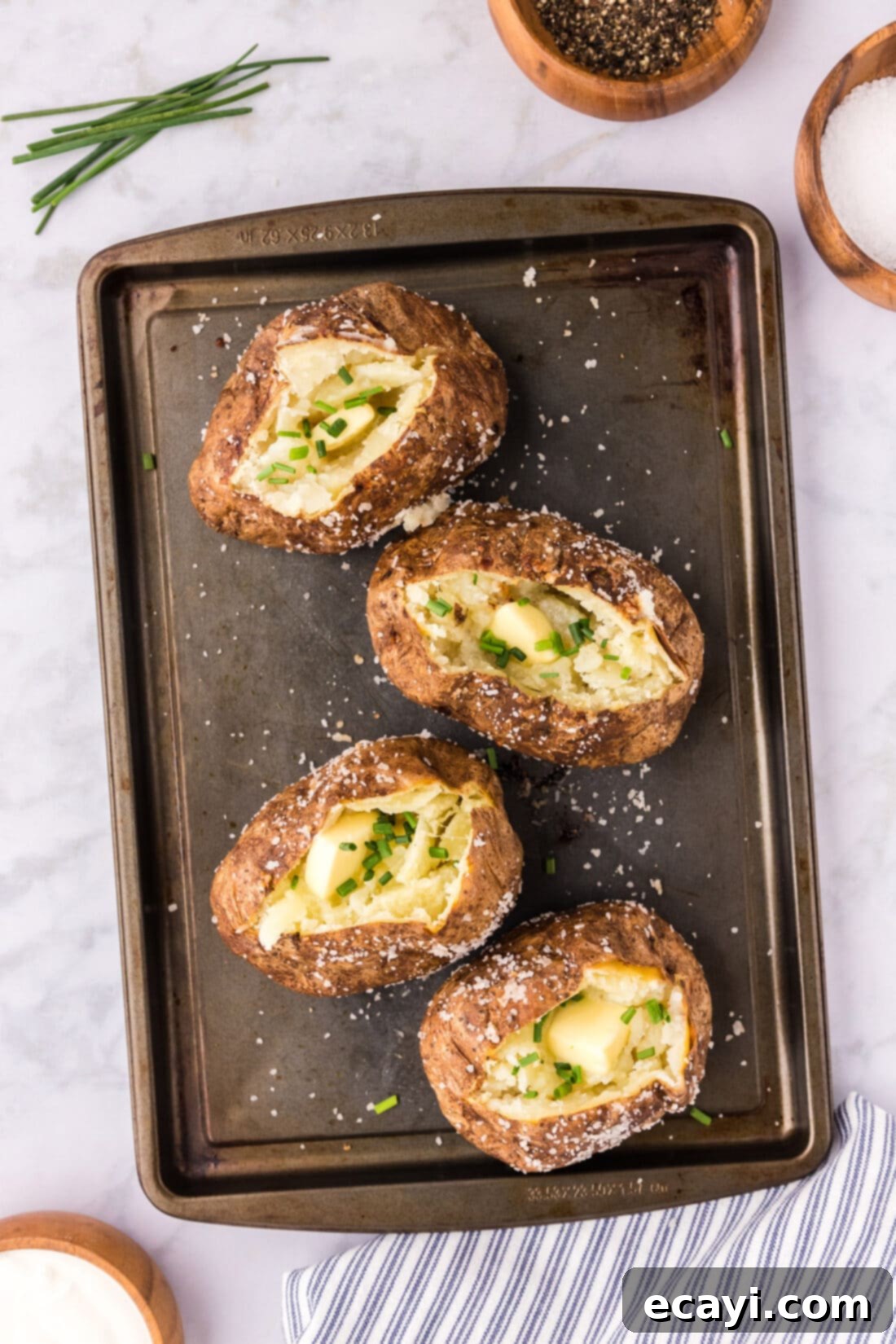
Essential Ingredients for Your Perfect Baked Potatoes
Creating these outstanding baked potatoes requires only a handful of ingredients, showcasing that culinary excellence doesn’t always demand a long list of components. The simplicity of this recipe allows the natural flavors and textures of the potato to truly shine. For precise measurements, detailed instructions, and a convenient printable version of this recipe, please refer to the recipe card located at the conclusion of this post.
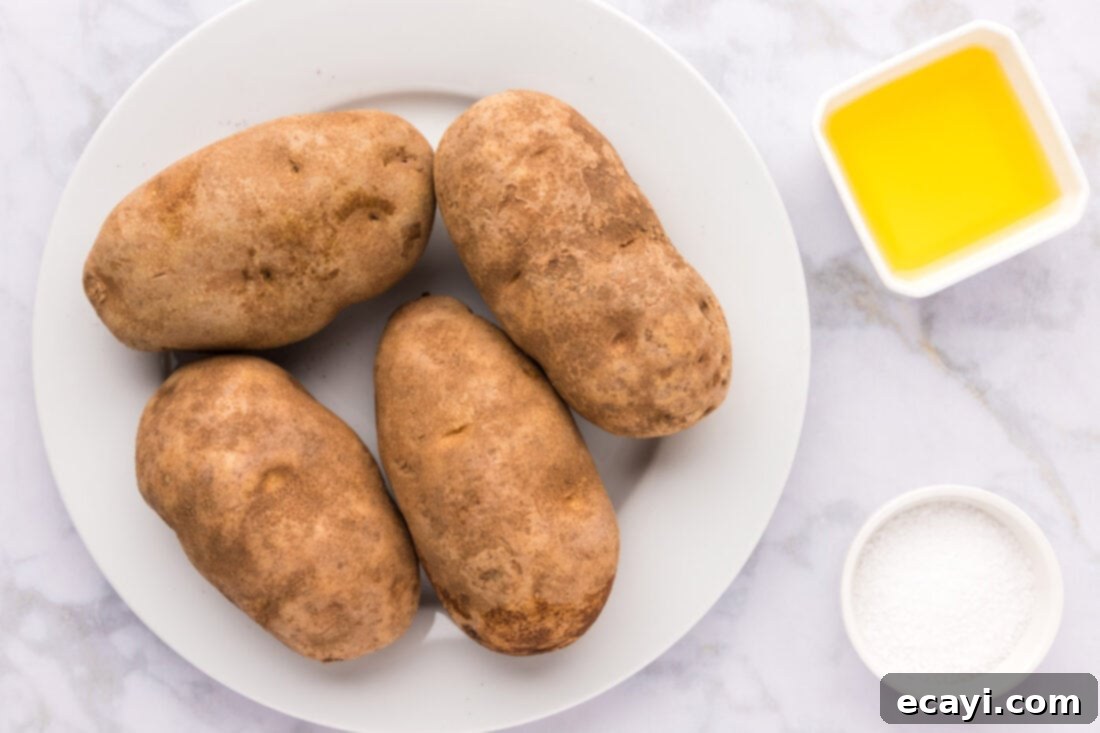
Ingredient Information and Expert Substitution Suggestions
Understanding your ingredients is key to successful cooking. While this recipe is straightforward, knowing why each component is chosen and what alternatives you might use can elevate your baked potato experience.
POTATOES – When it comes to baking, Russet potatoes (also known as Idaho potatoes) are unequivocally the champions. Their distinct characteristics make them perfectly suited for achieving that ideal fluffy interior and crispy skin. Russets are exceptionally starchy and have a relatively low moisture content, which prevents them from becoming waxy or dense during baking. This high starch content breaks down into a light, floury texture when cooked, making them incredibly easy to fluff with a fork. Furthermore, their thick, robust skins are excellent at crisping up beautifully when coated with oil and salt, creating a delightful textural contrast to the soft interior.
Substitution Suggestions: While Russets are highly recommended, other potato varieties can be used, though they will yield different results.
- Yukon Gold: These offer a creamier, more buttery texture with a thinner skin that crisps moderately well. They won’t be as “fluffy” as Russets but are still a good choice if you prefer a richer potato.
- Red or New Potatoes: These are waxy potatoes with a higher moisture content, making them less ideal for baking if a fluffy interior is your goal. They tend to stay firmer and denser.
When selecting potatoes, look for ones that are firm to the touch, free from blemishes, sprouts, or green spots (green indicates solanine, which can be bitter and is mildly toxic). Aim for potatoes of similar size to ensure even cooking.
OIL – The application of oil is crucial for achieving that coveted crispy skin. Olive oil is an excellent choice, providing a lovely flavor note and helping the skin to brown and crisp efficiently. The oil acts as a heat conductor, transferring the oven’s high temperature directly to the potato skin, drying it out and making it shatteringly crisp.
Substitution Suggestions:
- Other Vegetable Oils: Canola oil, grapeseed oil, peanut oil, or avocado oil are all fantastic alternatives. They have high smoke points, meaning they can withstand the oven’s high temperature without burning, and are generally neutral in flavor, allowing the potato’s natural taste to dominate.
- Melted Butter: For a richer flavor, you can rub the potatoes with melted butter. While it contributes to a delicious taste, butter contains more water solids than oil, which might result in a slightly less crispy skin compared to pure oils. However, many find the flavor worthwhile.
- Bacon Fat or Duck Fat: For an exceptionally savory and ultra-crispy skin, rendered bacon fat or duck fat can be a luxurious choice. These fats infuse a deep, smoky flavor that complements the potato beautifully.
Ensure an even coating of oil over the entire potato surface for uniform crisping.
KOSHER SALT – Salt is not just for seasoning; it plays an important role in the crisping process. Sprinkling Kosher salt generously over the oiled potato skin not only enhances the flavor but also helps to draw out any residual moisture from the surface, further contributing to a dry, crunchy skin.
Substitution Suggestions:
- Sea Salt: Flaky sea salt is another excellent option. Its larger crystals adhere well and provide a wonderful textural crunch and burst of briny flavor.
- Table Salt: While table salt can be used, its fine grains mean you’ll need less of it as it’s saltier by volume. It also doesn’t provide the same textural element as Kosher or sea salt.
Feel free to add other seasonings to your salt, such as garlic powder, onion powder, or a pinch of paprika, for extra flavor dimensions on the skin.
Step-by-Step Guide: How to Make Perfect Baked Potatoes
These step-by-step photos and detailed instructions are provided to help you visualize each stage of making this recipe. For a convenient printable version, complete with precise measurements and instructions, simply Jump to Recipe at the bottom of this post.
- Preheat Your Oven to 425°F (220°C). This high temperature is crucial for crisping the skin and ensuring the potato cooks thoroughly and quickly. Allow your oven ample time to reach and maintain this temperature before placing the potatoes inside. A properly preheated oven provides the initial blast of heat needed to set the skin and start the crisping process immediately.
- Wash and Thoroughly Dry Potatoes. Rinse your Russet potatoes under cool running water, gently scrubbing away any dirt or debris with a vegetable brush. The most critical step here is to dry them completely. Excess moisture on the skin will hinder crisping, leading to a steamed rather than a baked texture. Use a clean kitchen towel or paper towels to ensure each potato is bone-dry.
- Pierce Potatoes with a Fork. Using a fork, carefully but firmly pierce each potato several times, making about 6-8 punctures all around its surface. These small holes act as vents, allowing steam to escape from the potato’s interior as it bakes. This prevents pressure buildup that could cause the potato to burst and, more importantly, ensures a light, fluffy texture rather than a dense, wet one.
- Rub with Olive Oil and Season Generously with Kosher Salt. Pour a tablespoon of olive oil onto your hands or directly onto the potatoes. Rub the oil evenly over the entire surface of each potato, ensuring every inch is lightly coated. This oil layer is vital for achieving that beautiful golden-brown and crispy skin. Next, sprinkle a generous amount of Kosher salt over the oiled potatoes. The larger flakes of Kosher salt adhere well and contribute both flavor and an appealing texture to the finished skin.
- Bake for 1 Hour. Arrange the prepared potatoes in a single layer on a baking sheet. Ensure there is enough space between each potato for air to circulate, which further promotes even cooking and crisping. Place the baking sheet into the preheated 425°F oven and bake for approximately 1 hour. Baking time can vary slightly depending on the size of your potatoes, so a good indicator of doneness is when the skin is very crisp and the interior feels tender when squeezed (using oven mitts!). You can also insert a fork into the center; it should slide in with very little resistance. For extra crispiness and even cooking, you can flip the potatoes halfway through the baking time.
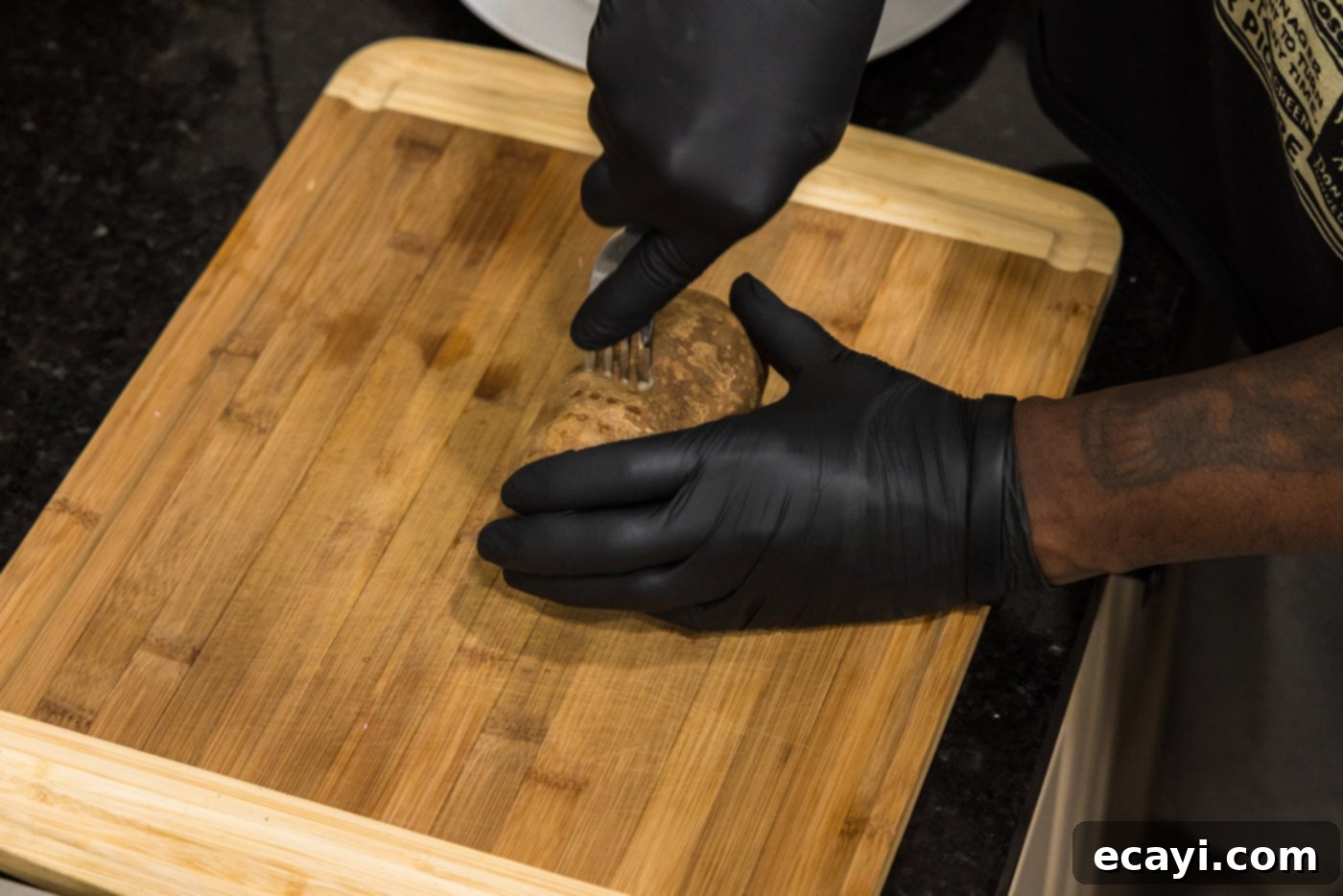
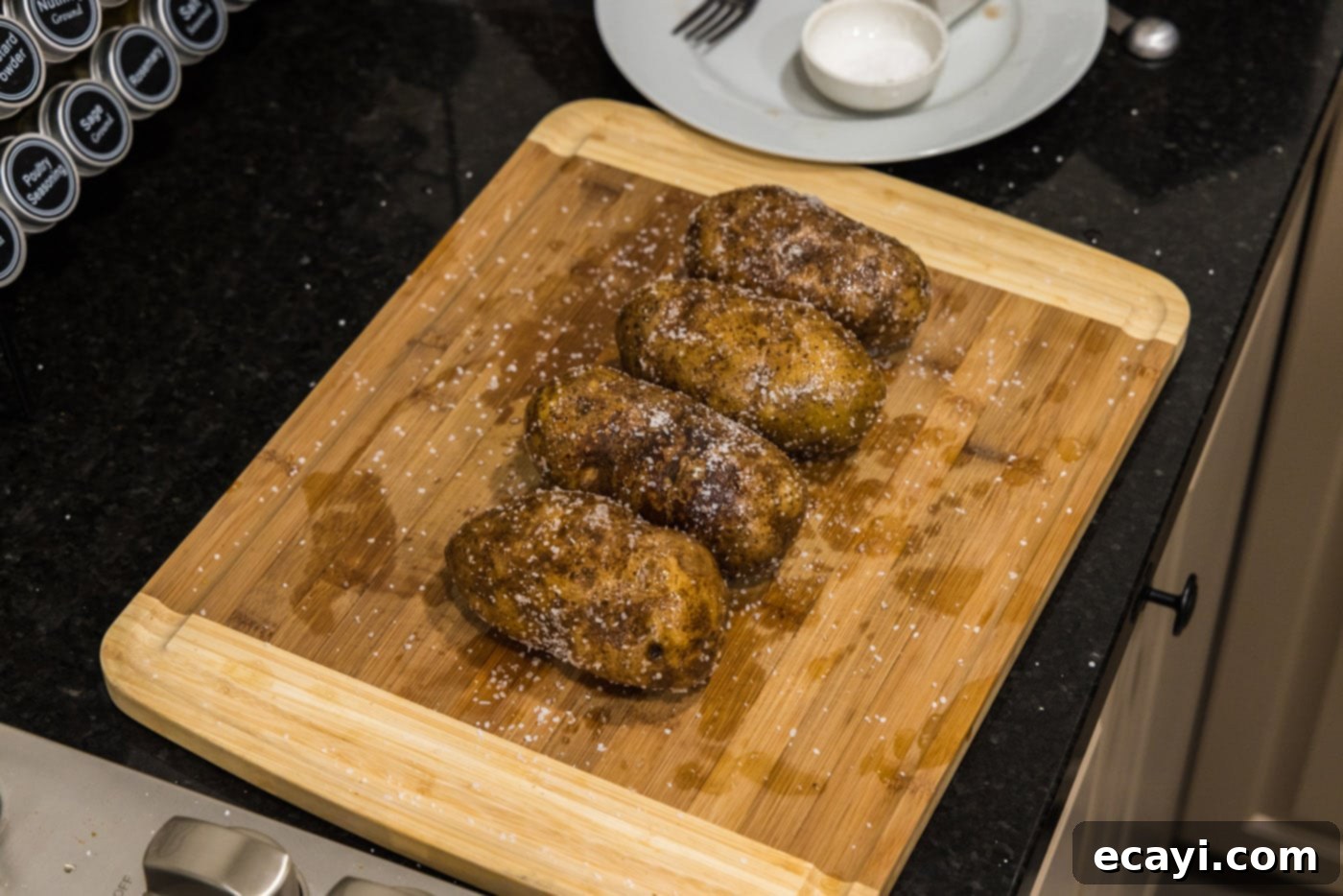
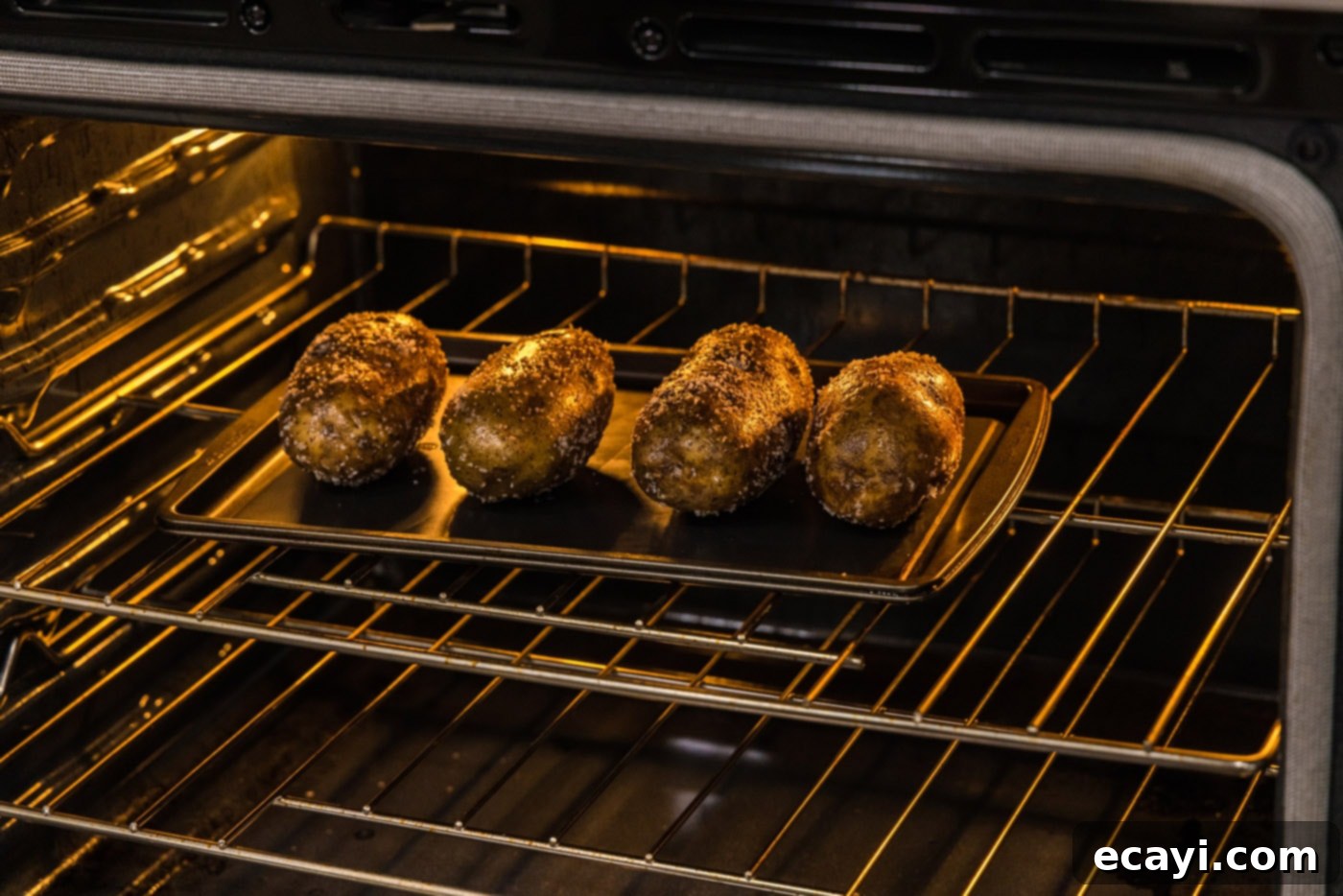
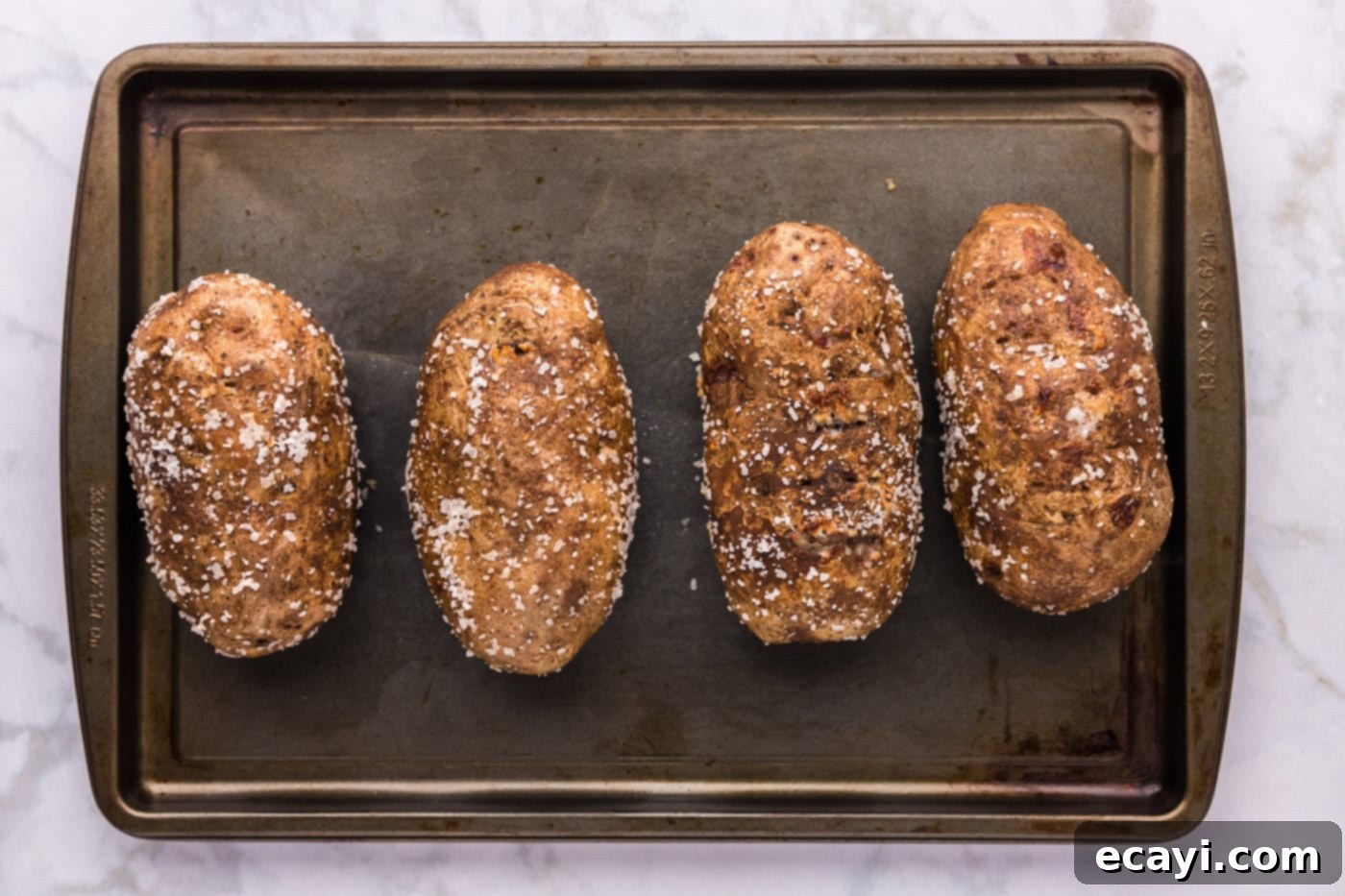
Frequently Asked Questions & Expert Tips for Baked Potatoes
No, I emphatically do not recommend wrapping potatoes in foil before baking if you desire a truly crispy skin. Wrapping them in foil effectively steams the potato as it bakes, trapping all the moisture. While this might result in a soft interior, the skin will remain disappointingly wet and soggy, completely missing out on that desirable crunch. If a soft skin is your preference, then foil is fine, but for the classic crispy exterior, always bake them unwrapped.
Poking holes in the potatoes before baking is a crucial step that allows excess steam to escape from the interior of the potato. Potatoes naturally contain a lot of moisture, which converts to steam under high heat. If this steam is trapped, pressure builds up inside the potato. While an exploding potato isn’t a common occurrence, the trapped steam can lead to an unevenly cooked, dense, or watery interior. More importantly, releasing the steam contributes to the light, fluffy texture that defines a perfect baked potato.
Store any leftover baked potatoes in an airtight container in the refrigerator for 2-3 days. To reheat and restore some crispiness to the skin, place them on a baking sheet in a 350°F (175°C) oven for 10-15 minutes, or until they are warmed through to your liking. For a quicker reheat, you can microwave them, but be aware that this method will result in a softer skin. Never store baked potatoes wrapped tightly in foil at room temperature for extended periods, as this creates an anaerobic environment that can promote the growth of Clostridium botulinum.
There are a couple of reliable ways to test for doneness. The simplest method is to gently squeeze the potato (using an oven mitt, of course!). A perfectly baked potato will feel soft and yielding throughout. You can also insert a fork or skewer into the center; it should slide in with very little resistance. For the most precise measurement, an instant-read thermometer inserted into the thickest part of the potato should register between 205-212°F (96-100°C).
The moment a baked potato comes out of the oven, its internal temperature is very high, and moisture is rapidly evaporating. To achieve the fluffiest possible interior, slice the potato lengthwise immediately after baking. Then, using oven mitts, gently push the ends of the potato towards the center, causing the fluffy interior to burst upwards. Quickly run a fork through the flesh to aerate it further. A small pat of butter or a drizzle of cream at this stage will melt into the hot potato, enhancing its luxurious texture and flavor.
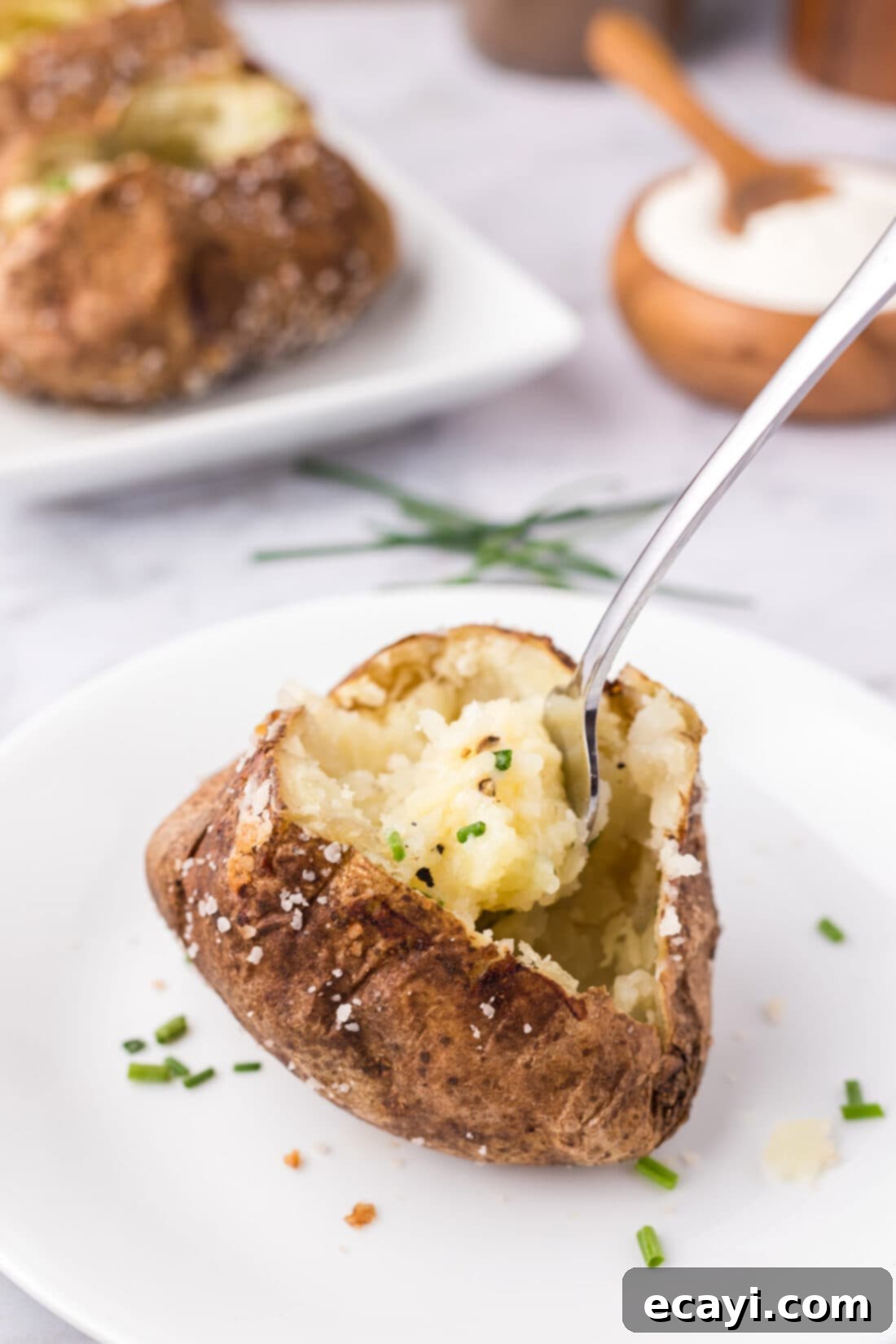
Creative & Delicious Serving Suggestions for Baked Potatoes
The beauty of a perfectly baked potato lies in its incredible versatility, serving as a hearty base for an endless array of toppings. Once you’ve achieved that ideal crispy skin and fluffy interior, the only limit is your imagination!
Classic Toppings:
- Dairy Delights: A generous dollop of sour cream or Greek yogurt, a melting pat of butter, and a sprinkle of freshly chopped chives or green onions are timeless favorites that offer a creamy, tangy contrast to the warm potato.
- Cheesy Goodness: Shredded cheddar, Monterey Jack, or a sharp Parmesan cheese melt beautifully into the hot potato, adding rich flavor and gooey texture.
- Crispy Bits: Crumbled bacon bits or vegetarian bacon alternatives provide a salty, smoky crunch.
Hearty & Savory Options:
- Chili Loaded: Top your potato with a warm, hearty bowl of beef or vegetarian chili for a complete and satisfying meal.
- Pulled Meats: Slow-cooked pulled pork, shredded BBQ chicken, or tender beef barbacoa transform a simple potato into a robust main course.
- Broccoli Cheddar: Steamed broccoli florets, combined with melted cheddar cheese, offer a delicious and nutritious combination.
- Spicy Kick: Diced fresh or pickled jalapeños, a dash of hot sauce, or a sprinkle of red pepper flakes can add a vibrant heat.
Vegetarian & Gourmet Ideas:
- Sautéed Mushrooms and Onions: A savory mix of garlic-sautéed mushrooms and caramelized onions adds earthy depth.
- Roasted Vegetables: Roasted bell peppers, zucchini, or sweet corn salsa bring color, texture, and fresh flavors.
- Black Beans & Avocado: A scoop of seasoned black beans, topped with creamy diced avocado and a squeeze of lime, makes for a healthy and flavorful meal.
- Gourmet Touches: A drizzle of truffle oil, a dollop of crème fraîche, or even a few flakes of smoked salmon can elevate your baked potato to a sophisticated dish.
For entertaining, consider setting up a “Loaded Potato Bar” at parties. Simply bake a batch of potatoes and arrange a variety of toppings in separate bowls. This allows guests to customize their own creations, making for a fun and interactive dining experience. Alternatively, if you prefer to keep things delightfully simple, enjoy your warm baked potato fresh from the oven with nothing more than a generous pat of butter and a sprinkle of black pepper. The options truly are endless, ensuring there’s a perfect baked potato combination for every palate and occasion.
Discover More Delicious Potato Recipes
If you love potatoes as much as we do, you’ll be thrilled to explore our other fantastic potato-centric recipes. From crispy sides to comforting soups, there’s a potato dish for every craving:
- Irresistible Potato Wedges
- Creamy & Comforting Baked Potato Soup
- Flavorful Garlic Roasted Potatoes
- Quick & Easy Air Fryer Baked Potatoes
- Hearty Loaded Mashed Potato Casserole
- Classic & Crispy Potato Skins
I absolutely adore cooking and baking, and there’s nothing I enjoy more than sharing my culinary adventures and tested kitchen experiences with all of you! Remembering to revisit for new recipes daily can sometimes be a challenge, which is why I offer a convenient newsletter delivering fresh recipes directly to your inbox every time a new post goes live. Simply subscribe today and start receiving your free daily recipes, making sure you never miss out on delicious inspiration!
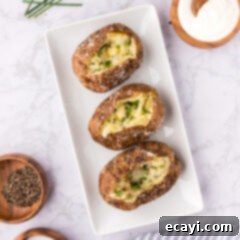
Classic Oven Baked Potatoes
IMPORTANT – Don’t forget to check out the Frequently Asked Questions and Expert Tips section within the blog post above for additional helpful insights and troubleshooting advice!
Print It
Pin It
Rate It
Save ItSaved!
Ingredients
- 4 large Russet potatoes
- 1 Tablespoon olive oil
- 1 Tablespoon Kosher salt
Equipment You’ll Need
-
Baking sheet
Expert Tips & Notes
- Piercing the potatoes is essential to allow extra steam to escape, which results in a fluffy interior and prevents the potatoes from bursting.
- For crisp skin, do NOT wrap potatoes in foil before baking. Foil traps moisture, steaming the potatoes and resulting in soggy skins.
- Achieve the fluffiest interior by slicing the hot potato open and gently fluffing the flesh with a fork immediately after baking.
- Garnish your baked potatoes with an abundance of your favorite toppings! Popular choices include sour cream, butter, and fresh chives. Other delicious additions are cheddar cheese, steamed broccoli, crispy bacon bits, hearty chili, or diced jalapeños for a kick. You can also load them up with shredded pork, chicken, or beef for a complete meal. The customization options are truly endless!
- For even cooking and crispier skin, ensure potatoes are placed in a single layer on the baking sheet with space between them, and consider flipping them halfway through baking.
Instructions
-
Preheat your oven to 425°F (220°C). Ensure the oven is fully preheated for optimal crisping.
-
Wash the Russet potatoes thoroughly under cool water and dry them completely with a clean towel. This step is crucial for crispy skin.
-
Using a fork, pierce each potato about 6-8 times all over its surface. This allows steam to escape during baking.
-
Rub olive oil evenly all over the potatoes. Then, sprinkle generously with Kosher salt, ensuring the entire surface is coated.
-
Place the prepared potatoes in a single layer on a baking sheet. Bake for 1 hour, or until the skin is crisp and the interior is fork-tender (internal temperature should be 205-212°F / 96-100°C).
Nutrition Information
The recipes on this blog are meticulously tested using a conventional gas oven and gas stovetop. Please note that cooking and baking times can vary due to differences in individual ovens, particularly older models that may heat inconsistently. We highly recommend using an inexpensive oven thermometer to ensure your oven maintains the precise temperature required for optimal results. If you are using a toaster oven or a countertop oven, be aware that their heat distribution may differ from a full-sized conventional oven, potentially requiring adjustments to your cooking or baking times. For recipes prepared with specialized appliances like pressure cookers, air fryers, or slow cookers, a link to the specific appliances we use is typically provided within each respective recipe. In the case of baking recipes where measurements are given by weight, please be advised that substituting with cup measurements may alter the outcome, and we cannot guarantee comparable success with that method.
